Ian Evatt made a name for himself as a young and exciting manager with Barrow in the National League whom he managed to get promoted to League Two in the 2019/20 season, a side that was nicknamed ‘Barrowcelona’ for their exciting and possession-based style of play.
At the beginning of the 2020/21 campaign, Evatt left his post at Barrow and took over the manager’s position at Bolton Wanderers following the club’s relegation from League One. A lot of excitement came with the appointment as fans believed they would finally be treated to some excellent football for the first time in quite a while at the University of Bolton Stadium.
However, results did not go Evatt’s way for the first few months in charge of Bolton with the Wanderers picking up just seven wins in 24 league games. Now though, after slight tactical tweaks including the change to a 4-2-3-1, Bolton have shot up the table and are one of the most in-form teams in English football currently with eleven wins in their previous 13 games in the fourth division. They are now title contenders let alone promotion contenders, sitting in fourth place, just four points behind Cambridge United with a game in hand.
This article will be a tactical analysis in the form of a scout report of Bolton Wanderers in the past few months. It will specifically be an analysis of the tactics and principles of play that Evatt has built into his side’s style of play when they are in possession of the ball to see where Bolton have been so effective in their recent incredible unbeaten run.
Formation and typical starting lineup
Bolton Wanderers were a side who had a tendency to use a high volume of different formations this season with Evatt hoping to find the right one. When the English manager switched to a 4-2-3-1, their luck began to change and so did their unbeaten run and so this system has been the starting formation in every game since then. At times, Evatt has a tendency to switch to more of a 4-4-2 late in matches to hold onto a lead but this is nothing too anomalous for teams in such a situation.
The most important thing for Bolton has been that the starting eleven has been relatively the same throughout their recent matches, with very few changes made to the lineup unless Evatt’s hand is forced through incidents such as injuries, etc.
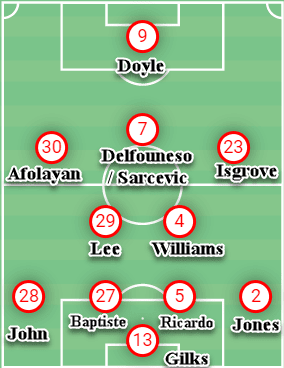
Here is the most used starting eleven for Bolton since the switch to a 4-2-3-1 back in January. Former Rangers goalkeeper Matt Gilks starts in goal for them and has done exemplary, keeping eight clean sheets in the thirteen-game unbeaten run, protected by a consistent back four comprising of ex-Swansea City man Declan John, Alex Baptiste, Ricardo Santos, and Gethin Jones.
The double-pivot is usually former Manchester United player Kieran Lee partnered alongside MJ Williams, providing defensive security to the backline with George Thomason sometimes being utilised if one of the main pair is injured, suspended, or even just need to be rested.
The third line of the 4-2-3-1 is made up of West Ham United loanee Oladapo Afolayan who plays off the left, Lloyd Isgrove on the right, as well as Nathan Delfouneso in the number 10 position, playing more of a supporting striker role. However, at times, club captain Antoni Sarcevic is deployed in the number 10 position, which usually means that Delfouneso drops to the bench or else onto the right side.
The lone striker has been Eoin Doyle who is League Two’s joint-third top goalscorer in the current campaign, bagging 16 goals for the club as well as 3 assists in 34 games. The Irishman also has a conversion rate of 22 percent and a shot accuracy of 53 percent.
Building out from the back
Bolton are a very possession-oriented side under Evatt, a change from their usual direct and long-ball style of play. The Wanderers have averaged 54.4 percent possession in League Two this season, the third-highest average possession percentage per 90 in the fourth tier of English football.
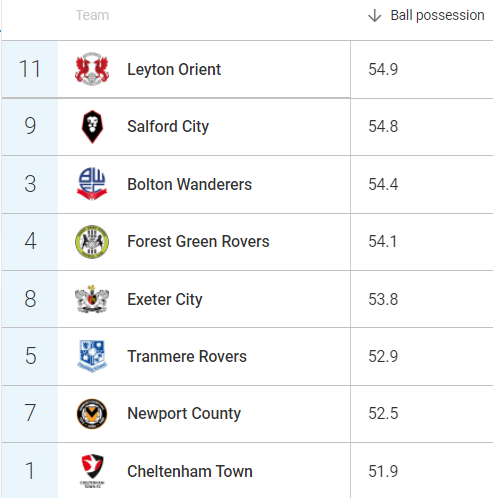
One of the principles of play that Bolton adheres to under Evatt is to try and play out from the back where applicable. Of course, there are times when playing out from the back can be quite difficult for a variety of reasons including the quality of the player as well as the quality of the opposition, but for the most part, Bolton do try and build their way through the thirds of the pitch.
When they are in the build-up phase, both fullbacks typically push slightly higher whilst the two centre-backs push wide to allow Gilks to be positioned in between them, almost like a back three.
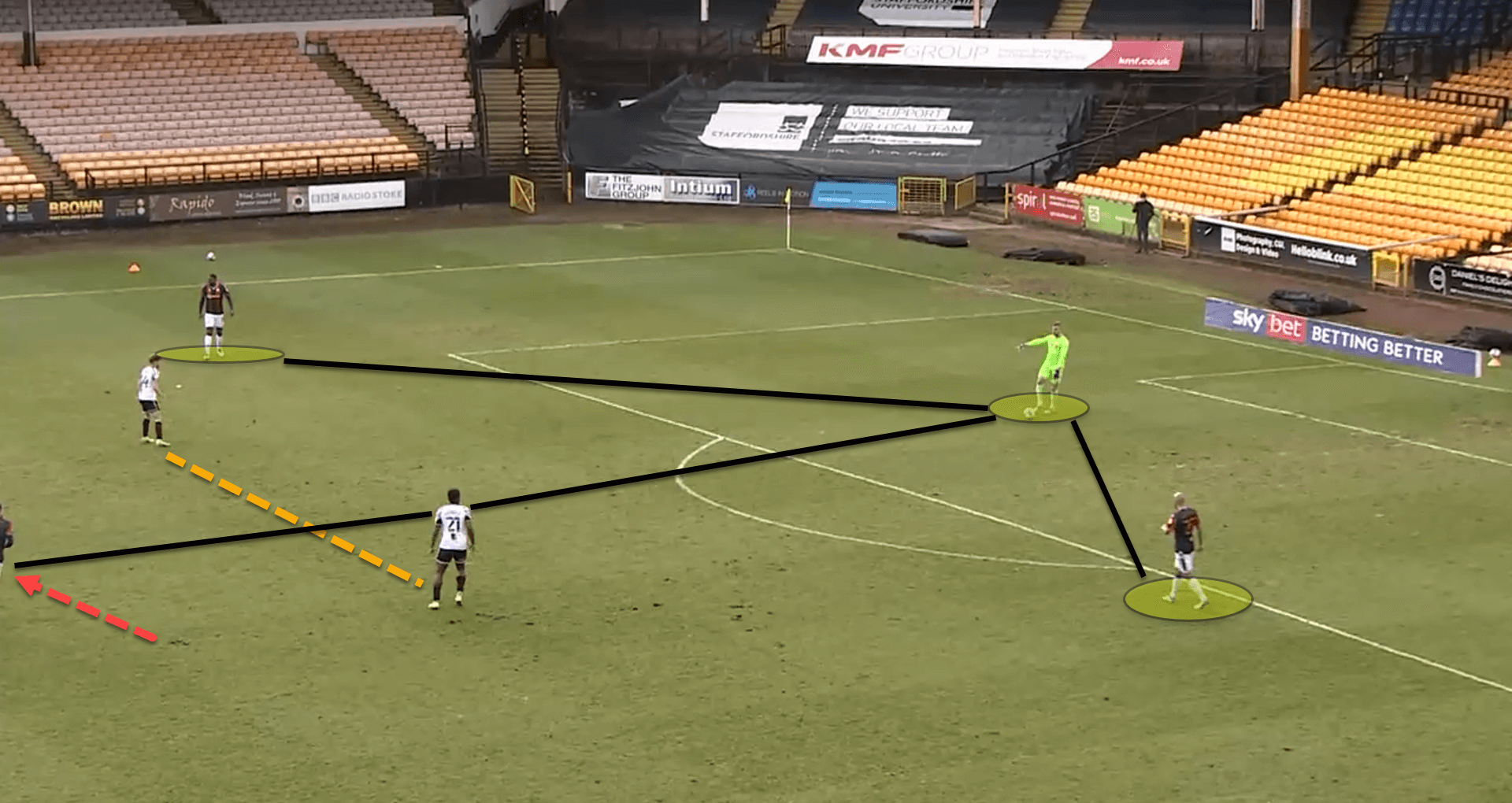
Here, we can see how Evatt sets his side up in the build-up phase. Both Baptiste and Ricardo have pushed wide to allow for Gilks to create a three-man line in front of the opposition’s first line of pressure. It cannot be seen from this image above, but the fullbacks have positioned themselves further up the pitch close to the halfway line to make room for the centre-backs who have split wider.
One player from the double-pivot, typically Williams, stays behind the first line of pressure from the opposition. This allows Bolton to have numerical superiority in front of the opposition’s first line as well as having an option to play through it. The other pivot player moves up behind the opponent’s second line to ensure that the team has numerical superiority between each line, a requisite for positional play.
Bolton will not always play out from the back though. At times, depending on the situation, they will play long from the goalkeeper as both Delfouneso and Doyle are very efficient in their aerial duels. When the ball is played long, the shape squeezes as the players look to hunt the ball down in numbers to win the knockdown or flick on.
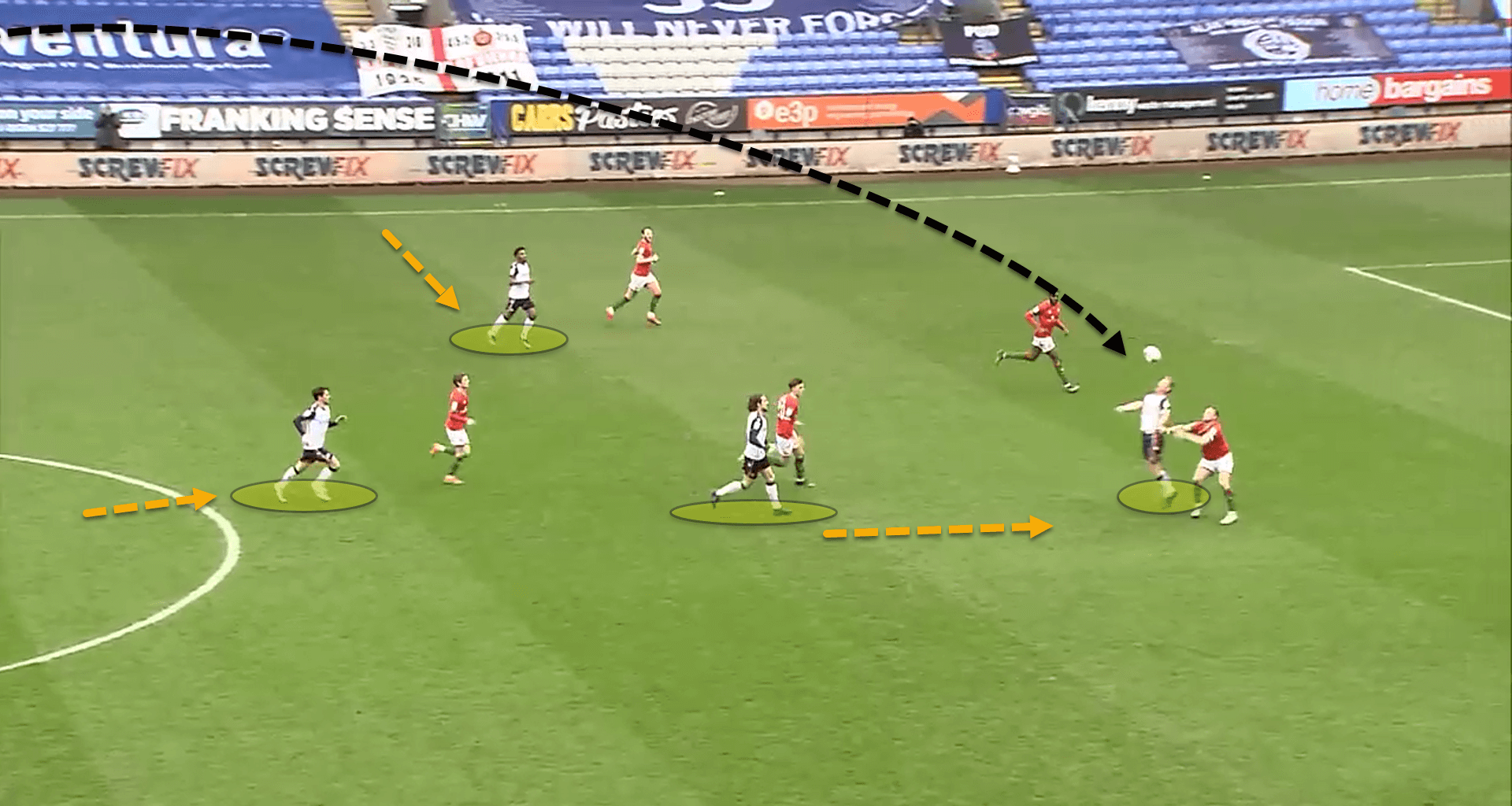
Set-up in a positional attack
Evatt’s side are quite adept at playing out from the back and progressing into a positional attack in the middle third of the pitch. When they are in these positional attacks, the team’s shape reverts back to the 4-2-3-1 base formation.
Bolton’s centre-backs position themselves rather deep on the pitch whilst the fullbacks move up close to the half-way line yet again, in line with the double-pivot.
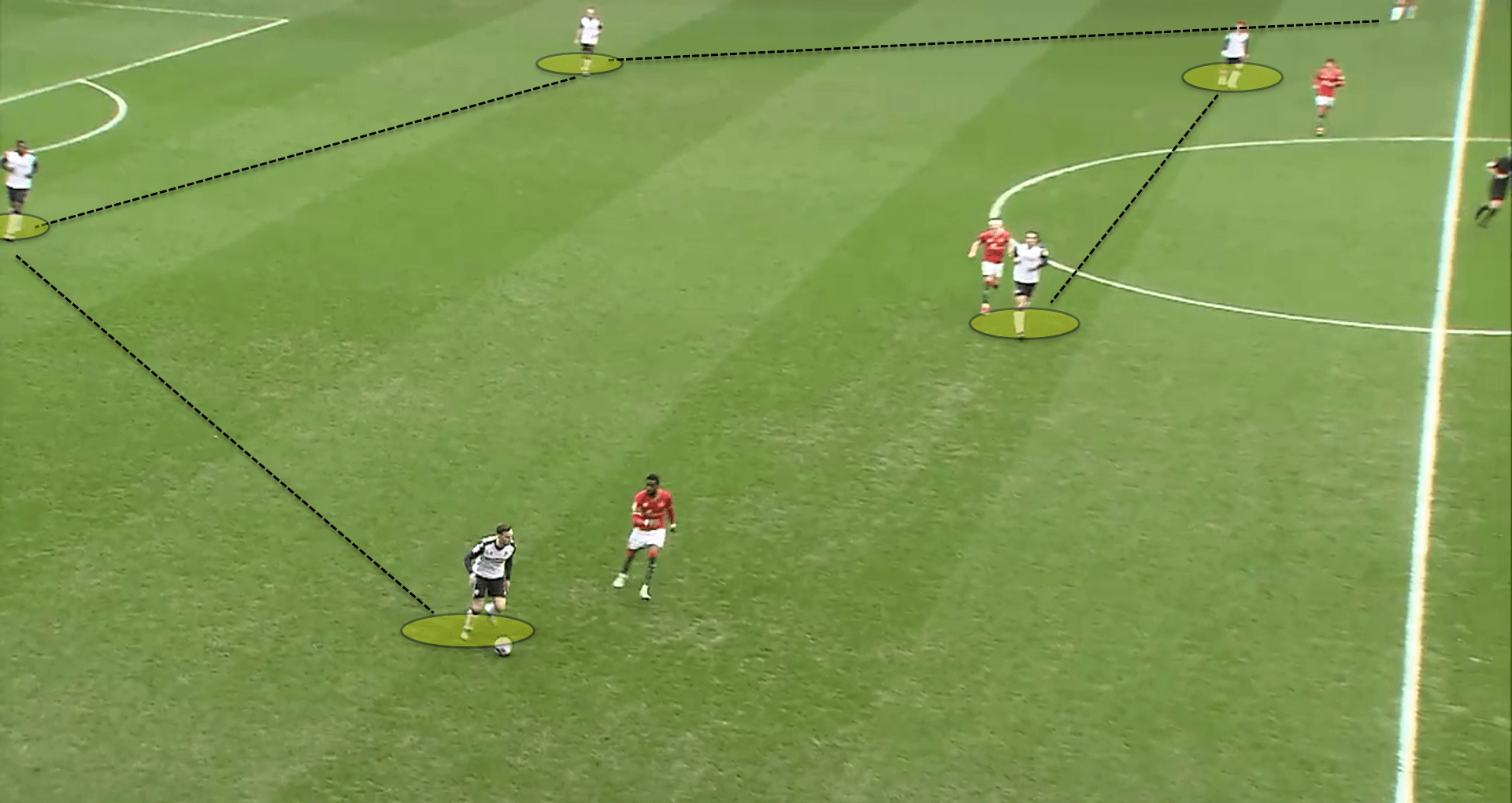
This makes the formation resemble a 2-4-3-1 and the reason for this is to protect the centre-backs Bolton are trying to progress the ball forward from deeper areas against a press. If they lose the ball, there is less distance to cover for the central defenders who are not particularly gifted with pace.
Bolton’s structure can change depending on the situation that their opponents present to them. A key aspect of positional play is numerical superiority with the backline, meaning that the team in possession must always have an extra man in front of the opposition’s first line, giving them the extra man.
If the other team are pressing with just one centre-forward, then just having two players in front of the first line of pressure is sufficient as they still have numerical superiority, but if the opposition is pressing with a two-man first line, one of the pivot players will drop beside the centre-backs to create a 3v2, maintaining the superiority.
Bolton are very fluid with this but doesn’t use the fullbacks to do so like quite a lot of teams. Both Williams and Lee take turns doing so with Williams dropping as a right centre-back next to Ricardo and Lee as a left centre-back alongside Baptiste, which all depends on the situation in front of them.
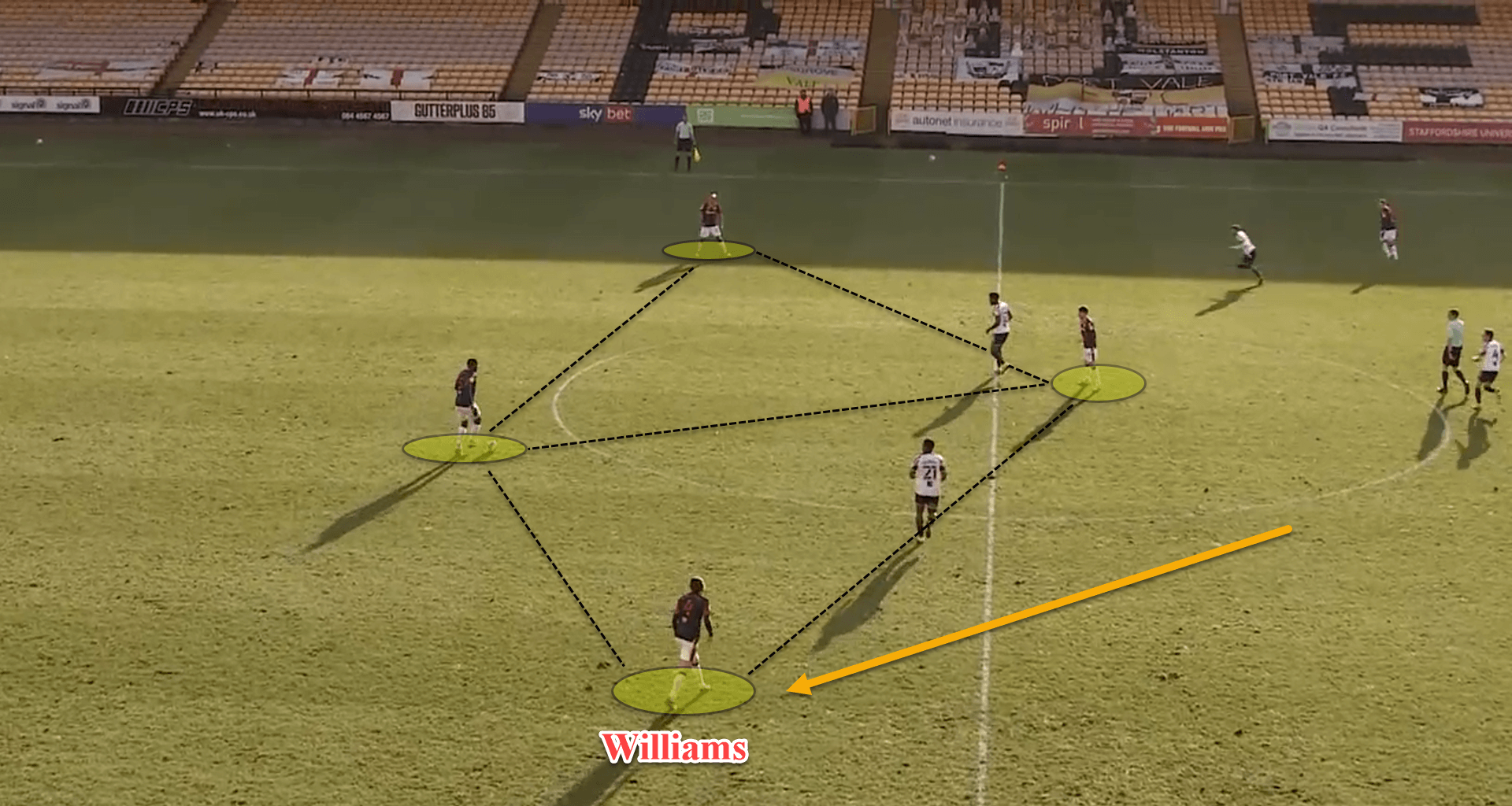
Here is an example of Bolton playing against a two-man first line of pressure. Williams has dropped to the right of Ricardo to gain superiority whilst Lee positioned himself behind the two forwards creating a 3 + 1 vs 2, which helps with progression.
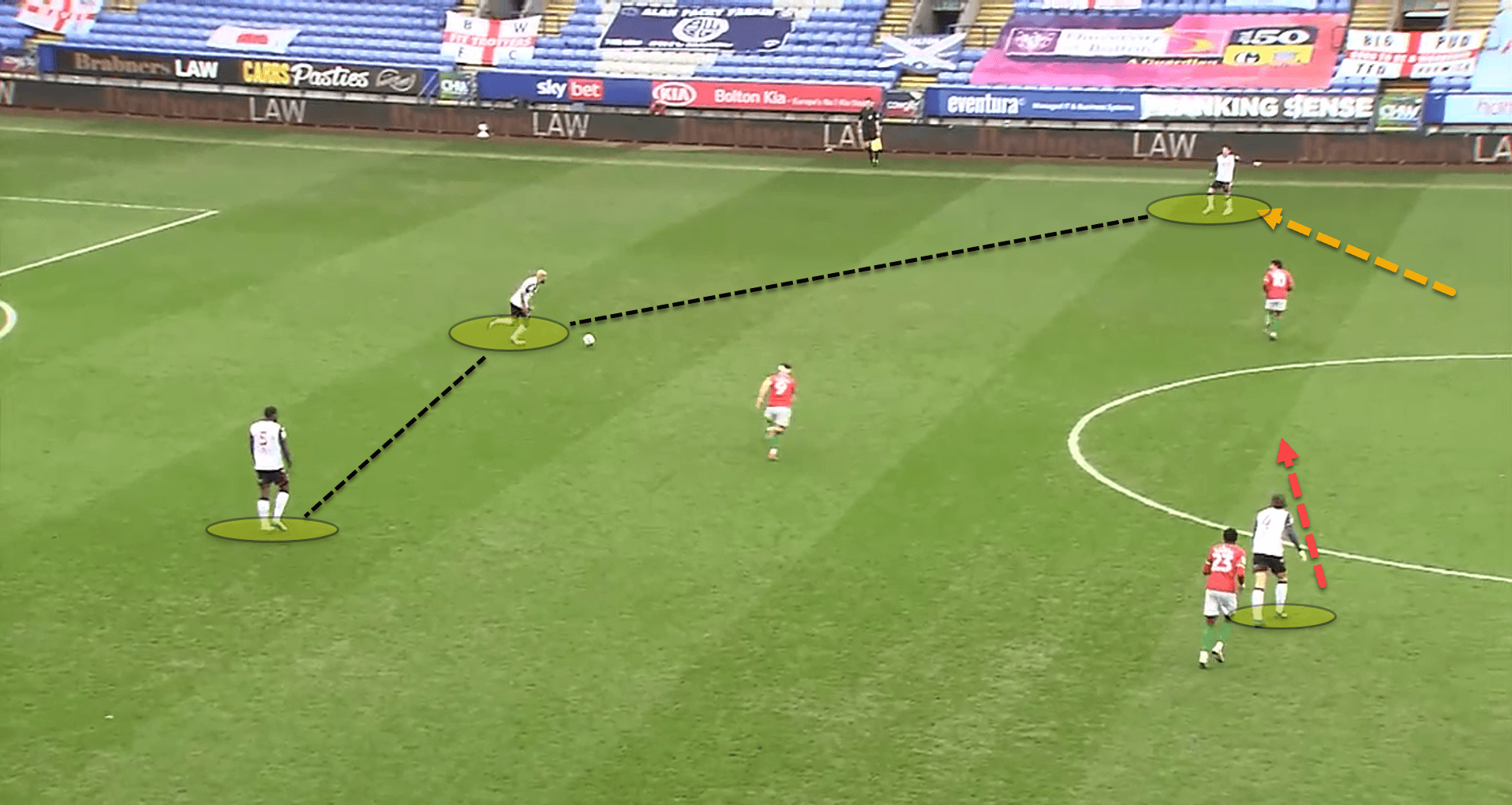
This image portrays Lee doing the same move on the far-side in a very similar scenario to the last. Their opponents in this game, Walsall, generally pressed with just one player in the first line of pressure, but the scenario has forced their right-winger inside which has created a two-man line, so Lee drops to the left flank to act as a temporary fullback, creating a 3 + 1 vs 2 once again, allowing for easy progression.
This merely just aids Bolton in breaking through the opposition’s press and to progress further up the pitch, beyond the halfway line. When they do reach the other half of the pitch, the third and fourth lines of the 4-2-3-1 get involved in the play to help circulate the ball, dropping deep into little pockets of space and acting as progressive passes.
Doyle, Delfouneso, and even Sarcevic when he plays, do this very well. They constantly drop between the lines and ask for the ball with their back to goal, using their physical power to hold off defenders before linking other players around them further up the pitch. This is a very useful way for Bolton to progress play through the central areas, something that they really lack at times.
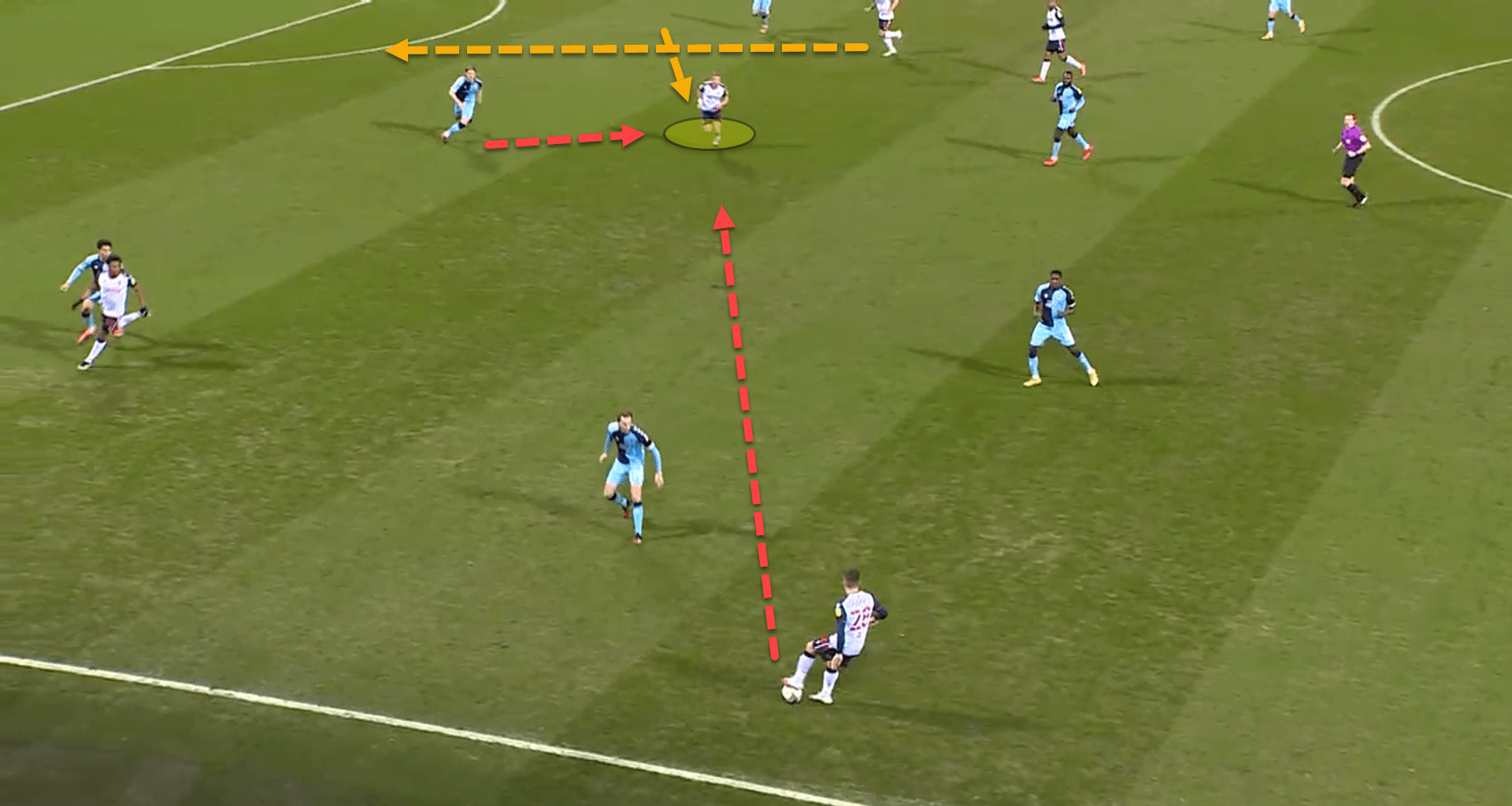
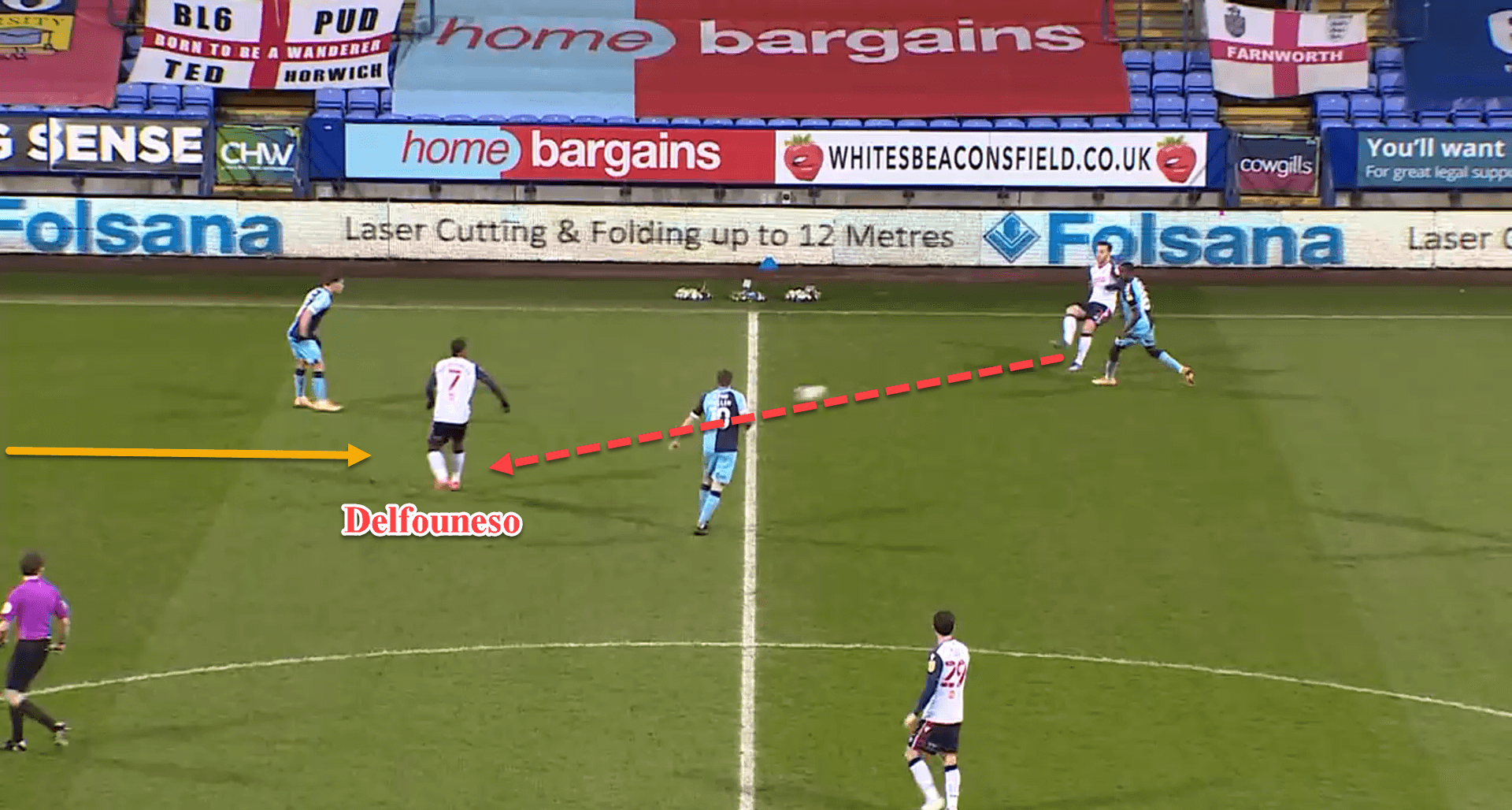
The constant movement and dropping between the lines of the front four give the double-pivot and the backline far more passing options to move the ball further up the pitch when Bolton are struggling to break through the opposition’s defensive block.
Using the fullbacks and wide overloads
Despite a lot of ball circulation and central passing options, Bolton struggle to create from central positions and in areas like Zone 14 with no real creative midfield player. As already stated previously in this article, Delfouneso and Sarcevic are not really attacking midfield players.
When Delfouneso starts as a number 10, he generally plays as more of a second-striker, whereas Sarcevic is more creative but tends to drop very deep almost as a central midfielder rather than staying between the lines.
As they have no real creativity further up the pitch, the two fullbacks are vitally important in the final third for Evatt’s side. Bolton pushes their fullbacks very high up the pitch when the ball is in the opposition’s half as the two wingers in the 4-2-3-1 invert to play inside, which essentially frees up the flanks just for the fullbacks.
The wide areas are the most used area of the pitch that Bolton attack into which can be seen from the following visual in one of their recent games in League Two.
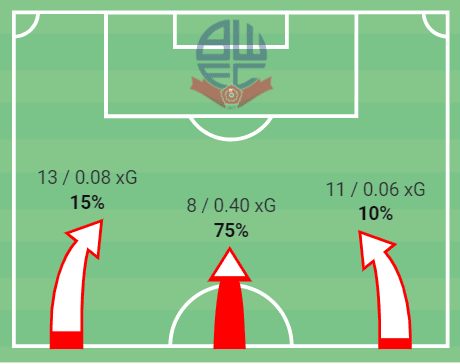
They like to use combination play in the wide areas to get the fullbacks into dangerous positions to cross the ball as well as underlapping and overlapping runs with the winger as such:
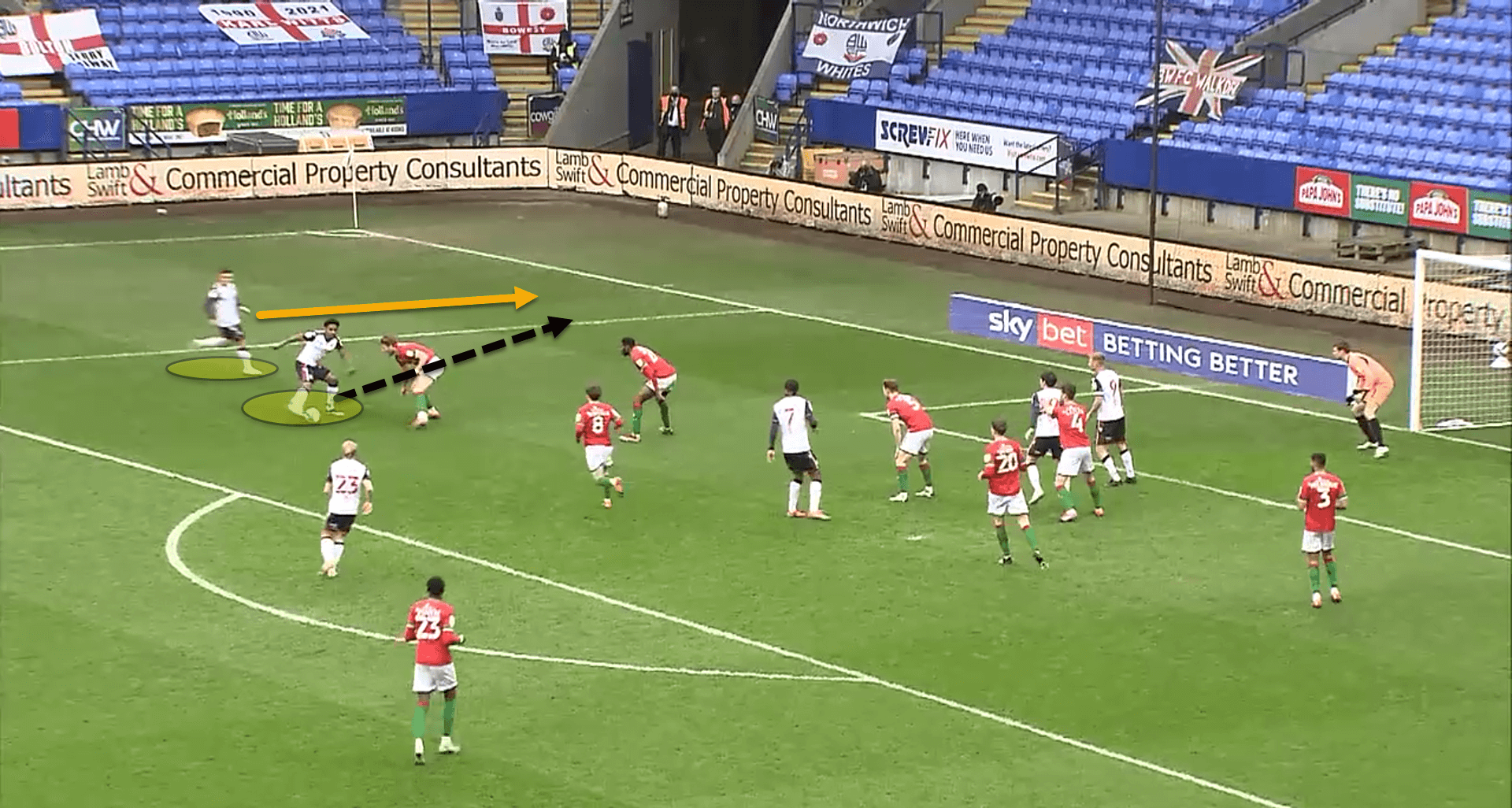
Here, the Afolayan’s run inside has dragged the opposition’s right-back with him, allowing for the overlap of John who is so dangerous in these types of areas.
Generally, when the fullbacks get into great crossing positions, Evatt instructs his players to pack the box, giving them an excellent numerical advantage to score from the balls into the penalty area.
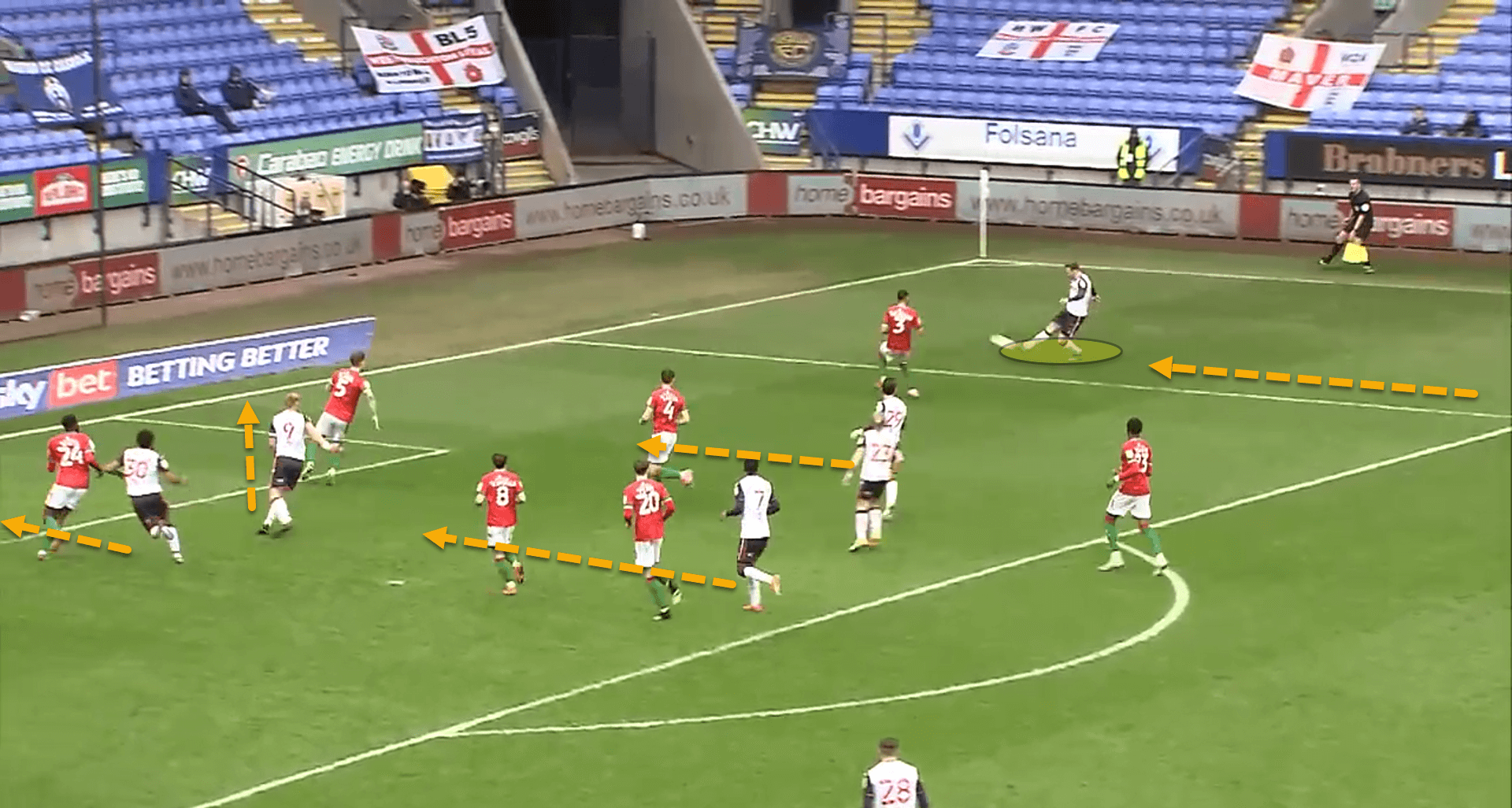
Bolton also create space for themselves on the flanks through wide overloads, similarly to Atalanta in Serie A. One of the main principles of positional play that they adhere to is overloading one area of the pitch in order to find a free man in space at the far side.
Wide overloads allow them to find this free man by packing one of the flanks, which forces the opposition to shift across so as to not be outnumbered on that side. This in turn creates space for a switch of play on the opposite side of the pitch as the opposition have all shifted over to one side.
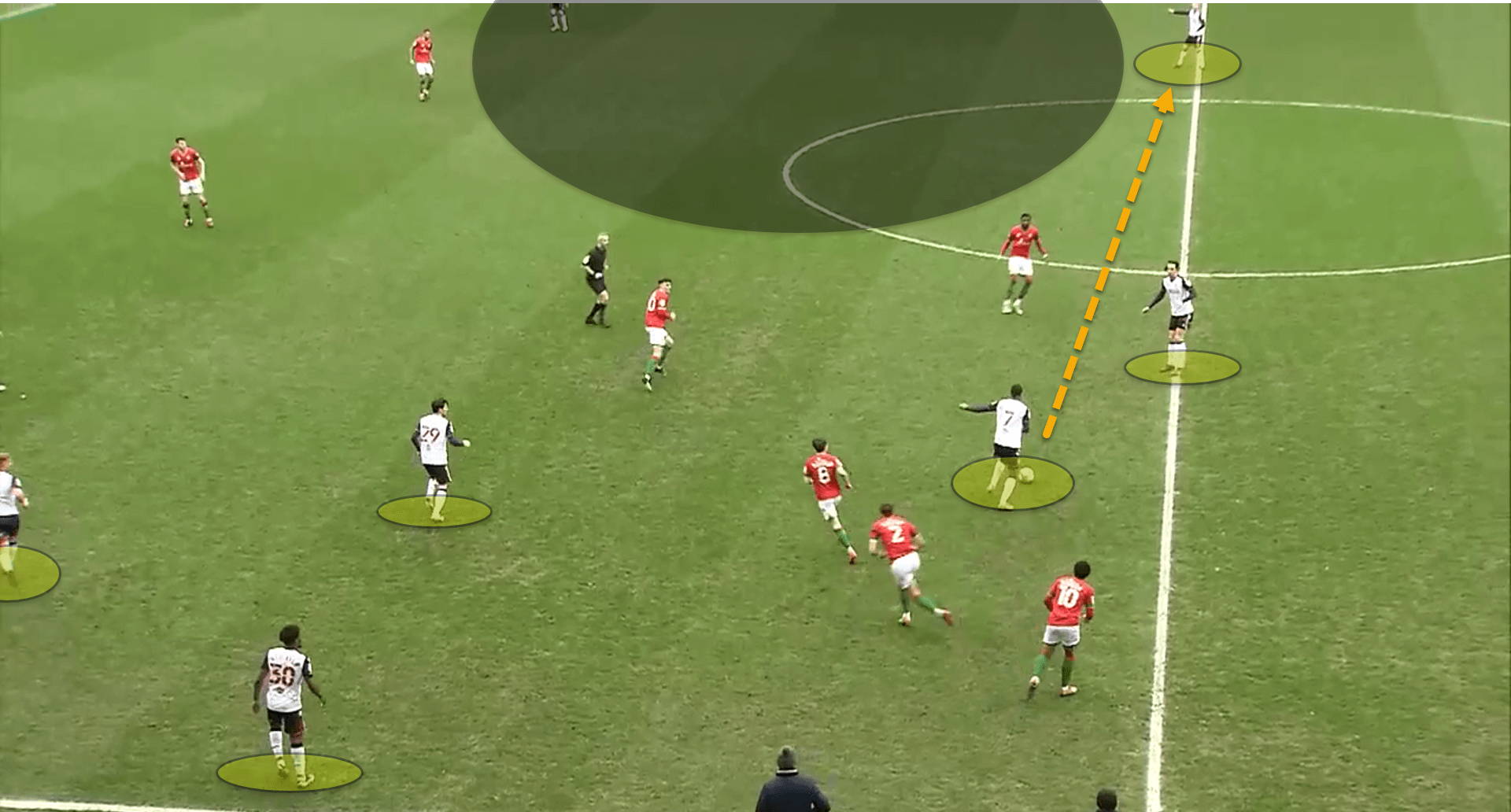
These wide overloads though are also a useful way to get in behind the opposition’s backline too. Instead of looking for a switch of play, Bolton can also use the wide overload to their advantage by finding a free man making a run in behind the opponent’s defensive line.
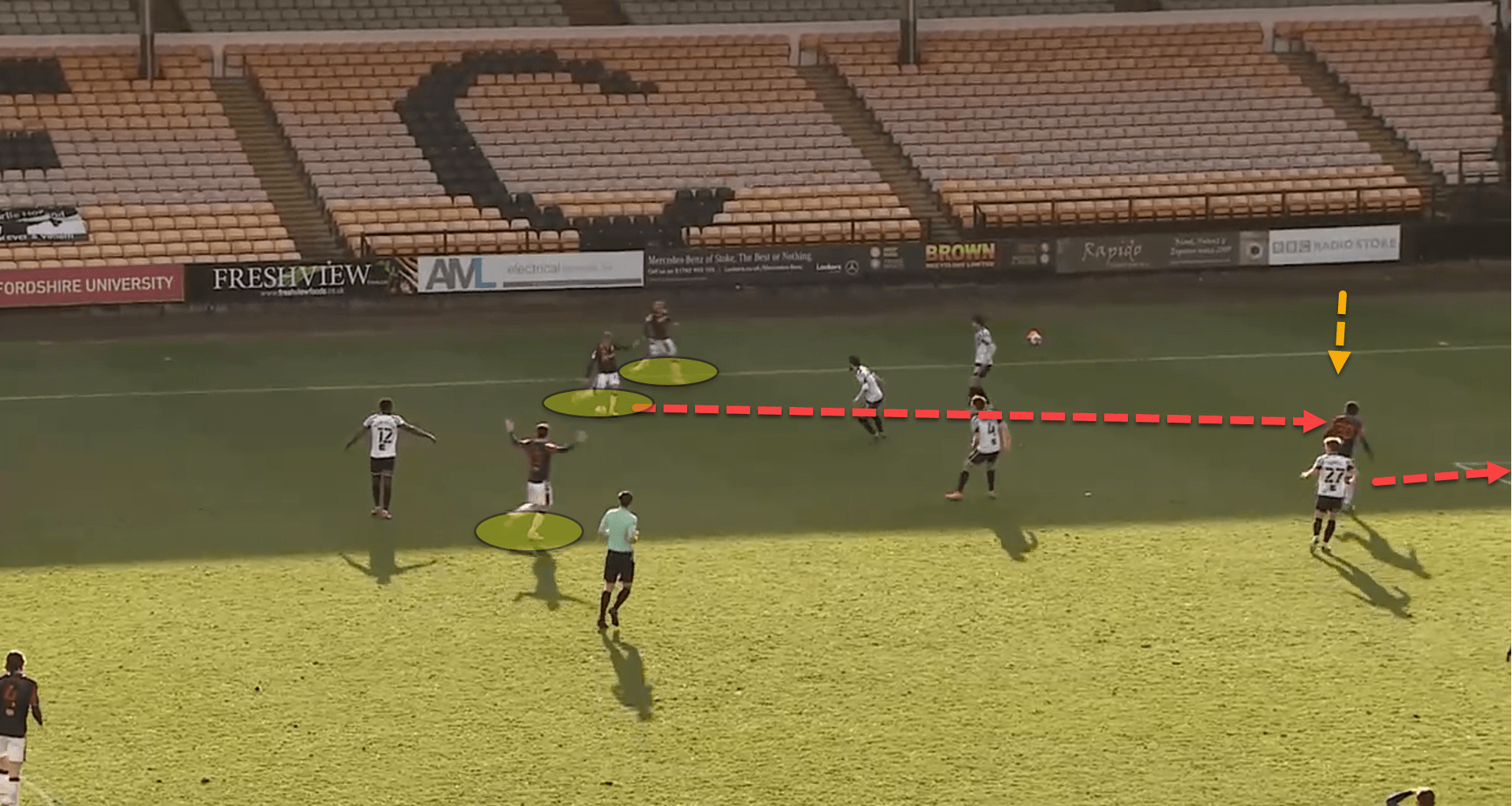
In this example, Bolton used a wide overload on the left flank to find Afolayan in space running behind Port Vale’s defensive line. The winger pulled the ball across the box, which eventually found Jones on the far side who slotted home the match-winning goal.
The variations in Bolton’s attacking play, which mainly comes from the wide areas, makes it very difficult to defend against them and gives them different ways of breaking down an opponent’s defensive set-up, especially if the other team is defending in a low-block which can be extremely difficult to break down without the right quality of players.
Conclusion
Evatt has certainly found the winning formula with Bolton. They have been a joy to watch at times this season, and even when games have been extremely tough and grueling, the Wanderers have managed to grind out results, a huge component of their game that has led them to be late challengers for the league title.
Their unbeaten run may not last for much longer with some tough games still to come but if they manage to win the majority of their games for the remainder of the campaign, Bolton and Evatt may gain automatic promotion at the very least, which is a huge success considering where they were at the turn of the year.






Comments